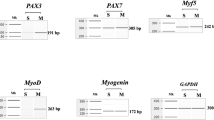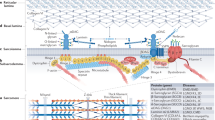Abstract
Duchenne muscular dystrophy (DMD), a sex-linked degenerative disorder of the muscle, is one of the most common lethal genetic diseases in man. It affects about one male in 3,500, with an estimated one-third of cases being caused by new mutations. A less severe disease, Becker's muscular dystrophy (BMD), maps to the same chromosomal locus and is most probably an allelic form of DMD. Both diseases are sometimes associated with various degrees of mental retardation; the molecular basis of these phenotypes is unknown (for review, see ref. 1). The giant DMD gene spans approximately 2,000 kilobases (kb) (0.05% of the human genome) and encodes a 14-kb mRNA2,3. The tissue-specificity of its expression has not been precisely determined. Monaco et al.2, using Northern blots, reported expression of the gene in human fetal skeletal muscle and small intestine but not in human fetal brain, or in human cultured myoblasts and transformed B and T cells. More recently, expression was detected in mouse skeletal and cardiac muscle, but not in mouse brain4. Here we show, using a ribonuclease protection assay, that the DMD gene is developmentally regulated in rat and mouse myogenic cell cultures, and that it is expressed in rat and mouse striated muscle, in mouse smooth muscle and in rat, mouse and rabbit brain. We could not detect transcripts in other non-muscle tissues.
This is a preview of subscription content, access via your institution
Access options
Subscribe to this journal
Receive 51 print issues and online access
$199.00 per year
only $3.90 per issue
Buy this article
- Purchase on Springer Link
- Instant access to full article PDF
Prices may be subject to local taxes which are calculated during checkout
Similar content being viewed by others
References
Moser, H. Hum. Genet. 66, 17–40 (1984).
Monaco, A. P. et al. Nature 323, 646–650 (1986).
Monaco, A. P. & Kunkel, L. M. Trends Genet. 3, 33–37 (1987).
Hoffman, E. P., Monaco, A. P., Feener, C. C. & Kunkel, L. M. Science 238, 347–350 (1987).
Melton, D. A. et al. Nucleic Acids Res. 12, 7035–7056 (1984).
Yabionka, Z. & Yaffe, D. Differentiation 8, 133–143 (1977).
Shani, M. et al. Devl Biol. 86, 483–492 (1981).
Yaffe, D. & Saxel, O. Differentiation 7, 159–166 (1977).
Sica, R. E. P. & McComas, A. J. Can. J. Neurol Sci. 5, 189–197 (1978).
Rowland, L. P. Archs Neurol. 33, 315–321 (1976).
Hoffman, E. P., Brown, R. H. & Kunkel, L. M. Cell (in the press).
Hoffman, E. P., Knudson, C. M., Campbell, K. P. & Kunkel, L. M. Nature 330, 754–758 (1987).
Slater, C. R. Nature 330, 693–694 (1987).
Hammonds, R. G. Cell 51, 1 (1987).
Auffray, C., Nageotta, R., Chambraud, B. & Rougeon, F. Nucleic Acids Res. 8, 1231–1241 (1980).
Yaffe, D. in: Tissue Culture, Methods and Applications (eds Kruse, P. F., & Patterson, M. K.) 106–114 (Academic, New York, 1973).
Author information
Authors and Affiliations
Rights and permissions
About this article
Cite this article
Nudel, U., Robzyk, K. & Yaffe, D. Expression of the putative Duchenne muscular dystrophy gene in differentiated myogenic cell cultures and in the brain. Nature 331, 635–638 (1988). https://doi.org/10.1038/331635a0
Received:
Accepted:
Issue Date:
DOI: https://doi.org/10.1038/331635a0
This article is cited by
-
In remembrance of David Yaffe
Skeletal Muscle (2020)
-
Normal and altered pre-mRNA processing in the DMD gene
Human Genetics (2017)
-
The fate of individual myoblasts after transplantation into muscles of DMD patients
Nature Medicine (1997)
-
The human dystrophin gene requires 16 hours to be transcribed and is cotranscriptionally spliced
Nature Genetics (1995)
-
The structural and functional diversity of dystrophin
Nature Genetics (1993)
Comments
By submitting a comment you agree to abide by our Terms and Community Guidelines. If you find something abusive or that does not comply with our terms or guidelines please flag it as inappropriate.



